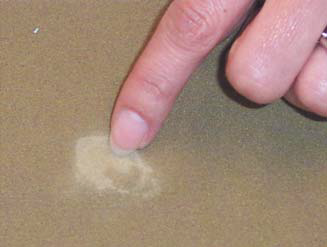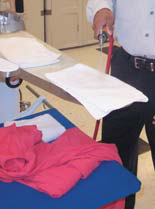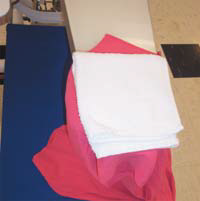PROTEIN STAINS
A large number of stains encountered by the spotter are protein stains. Often these stains are referred to as albumin stains. Albumin is a protein substance commonly found in animal tissues and liquids. Therefore, we will consider a protein stain as any stain that originates from a living animal such as eggs, milk, or blood. Other stains such as gravies, starches, and glues made from animal hides and bones will also fall into this category. Protein stains are water-soluble and should be removed by using wetside stain removal agents.
Identification

Color is not necessarily a distinguishing characteristic with protein stains. Food stains build up on the surface and are frequently stiff. When food stains are scratched lightly with the fingernail, they often take on a whitish appearance. A blood stain can be identified by applying several drops of 3% hydrogen peroxide. The stain will foam up if blood is present. Be certain to test for colorfastness before using hydrogen peroxide.
Removal of Protein Stains
This procedure can be used to remove stains such as:
- Milk
- Cheese
- Cottage cheese
- Ice cream
- Yogurt
- Eggs
- Gravies
- Saliva
- Urine
- Feces
- Vomit
- Perspiration
- Glues
- Blood
For proper removal of protein stains, have the following on hand:
Wet-side Agents
- Neutral Synthetic Detergent
- Protein Formula or Ammonia
- Digester
Special Tools
- White Towel
- Stain Removal Brush
Procedure
- Place a towel under the stained area.
- Place the stained area over the vacuum ring at the nose of the board, step on the vacuum pedal, and flush the area thoroughly with steam or water. This procedure alone may remove a large portion of the stain.
- Apply neutral synthetic detergent to the stained area.
- Remove the towel. Move the stained area to the solid surface of the board, and lightly tamp with a stain removal brush to break up the stain.
- Place a towel under the stained area, and flush the area thoroughly with steam or water to see if the stain has been removed.
- If the stain remains, apply protein formula or ammonia.
- Remove the towel, move the stained area to the solid surface, and tamp lightly with a stain removal brush.
- Place a towel under the stained area, and flush the area thoroughly with steam or water.
- If the stain remains, remove the towel and treat the stained area with a digester.
Digester




- Heat a clean towel.
- Place the clean towel under the stained area. Wet the area with steam.
- Apply the digester.
- Heat a second clean towel with steam.
- Place the towel on top of the stained area.
- Set the item aside.
- After 10 minutes, reapply the digester and reheat the top towel.
- Allow the digester to work for 20 minutes or longer, depending on the stain.
- After digestion, flush the area thoroughly with steam.
Note: Digesters must be used properly. Failure to follow the correct procedure will result in little or no removal of the stain.
DYE STAINS
Identification
Dye stains are absorbed into the fabric and are not stiff. Colors may vary.
Removal of Dye Stains
This procedure can be used to remove several stains, including:
- Highlighter markers
- Food coloring
- Magic markers
- Water colors
For proper removal of dye stains, have the following on hand:
Wet-side Agents
- Neutral Synthetic Detergent
- Tannin Formula or Acetic Acid 28%
- General Formula
- Rust Remover
- Protein Formula or Ammonia
- Bleach (Reducing)
Procedure
- Place a towel under the stained area.
- Place the stained area over the vacuum ring at the nose of the board, step on the vacuum pedal, and flush the area thoroughly with steam or water. This procedure alone may remove a large portion of the stain.
- Apply neutral synthetic detergent to the stained area.
- Remove the towel. Move the stained area to the solid surface of the board, and lightly tamp with a stain removal brush to break up the stain.
- Place a towel under the stained area, and flush the area thoroughly with steam or water.
- Apply acetic acid to the stained area.
- Tamp lightly with a stain removal brush.
- Place a towel under the stained area, and flush the area thoroughly with steam or water.
- If the stain remains, remove the towel and reapply the neutral synthetic detergent.
- Apply general formula.
- Tamp lightly with a stain removal brush.
- Place a towel under the stained area, and flush the area thoroughly with steam or water.
- If the stain remains, remove the towel and reapply the neutral synthetic detergent.
- 4) Apply several drops of rust remover. (Protect the stain removal board by keeping a towel between the board and the fabric.) Allow the rust remover to remain 5–8 seconds. With the towel under the stained area, flush with steam.
- Apply protein formula or ammonia.
- Tamp lightly with a stain removal brush.
- Place a towel under the stained area and flush the area thoroughly with steam or water.
- 18) If the stain remains, use a reducing bleach such as sodium bisulfite, sodium hydrosulfite, or titanium stripper. Before using any bleach, test the fabric for colorfastness.
- 19) When the stained area is clear, place a towel under the area, flush thoroughly, remove the towel, and dry the wet area completely.
This article is from DLI’s TOI-702.

